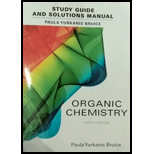
Concept explainers
What is the major product obtained from the reaction of each of the following compounds with excess HCl?
- a. CH3CH2C≡CH
- b. CH3CH2C≡CCH2CH3
- c. CH3CH2C≡CCH2CH2CH3
(a)
Interpretation:
The major product obtained from the reaction of given compound with excess of
Concept Introduction:
Addition of halides to alkynes: Halogens like chlorine and bromine adds to the alkyne compounds. The general form of the reaction is given below.

If excess halides are present, a second addition reaction also occurs.
Answer to Problem 29P
The major product obtained from the reaction of given compound with excess of

Explanation of Solution
Hydrogen halides undergo addition reaction with alkynes. Alkyne is a nucleophile and it reacts with the electrophile to give a

In this reaction of butyne with
(b)
Interpretation:
The major product obtained from the reaction of given compound with excess of
Concept Introduction:
Addition of halides to alkynes: Halogens like chlorine and bromine adds to the alkyne compounds. The general form of the reaction is given below.

If excess halides are present, a second addition reaction also occurs.
Answer to Problem 29P
The major product obtained from the reaction of given compound with excess of

Explanation of Solution
Hydrogen halides undergo addition reaction with alkynes. Alkyne is a nucleophile and it reacts with the electrophile to give a

In this reaction of hex-3-yne with
(c)
Interpretation:
The major product obtained from the reaction of given compound with excess of
Concept Introduction:
Addition of halides to alkynes: Halogens like chlorine and bromine adds to the alkyne compounds. The general form of the reaction is given below.

If excess halides are present, a second addition reaction also occurs.
Answer to Problem 29P
The major product obtained from the reaction of given compound with excess of

Explanation of Solution
Hydrogen halides undergo addition reaction with alkynes. Alkyne is a nucleophile and it reacts with the electrophile to give a

In this reaction of hept-3-yne with
Want to see more full solutions like this?
Chapter 7 Solutions
Student's Study Guide and Solutions Manual for Organic Chemistry
- Don't used Ai solutionarrow_forwardDon't used Ai solutionarrow_forwardIn mass spectrometry, alpha cleavages are common in molecules with heteroatoms. Draw the two daughter ions that would be observed in the mass spectrum resulting from an alpha cleavage of this molecule. + NH2 Q Draw Fragment with m/z of 72arrow_forward
- Write the systematic (IUPAC) name for each of the following organic molecules: F structure Br LL Br Br الحمد name ☐ ☐arrow_forwardDraw an appropriate reactant on the left-hand side of this organic reaction. Also, if any additional major products will be formed, add them to the right-hand side of the reaction. + + Х ง C 1. MCPBA Click and drag to start drawing a structure. 2. NaOH, H₂O Explanation Check OI... OH ol OH 18 Ar © 2025 McGraw Hill LLC. All Rights Reserved. Terms of Use | Privacy Center | Accessibilityarrow_forwardCalculate the atomic packing factor of quartz, knowing that the number of Si atoms per cm3 is 2.66·1022 and that the atomic radii of silicon and oxygen are, respectively, 0.038 and 0.117 nm.arrow_forward
